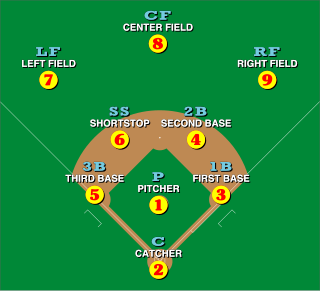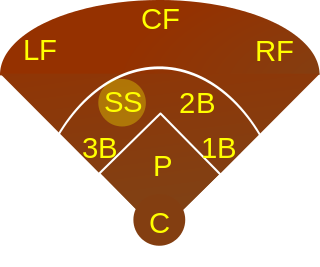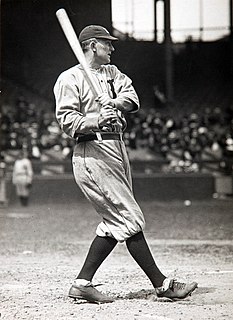
In the sport of baseball, each of the nine players on a team is assigned a particular fielding position when it is their turn to play defense. Each position conventionally has an associated number, for use in scorekeeping by the official scorer: 1 (pitcher), 2 (catcher), 3, 4, 5, 6 (shortstop), 7, 8, and 9. Collectively, these positions are usually grouped into three groups: the outfield, the infield, and the battery. Traditionally, players within each group will often be more able to exchange positions easily ; however, the pitcher and catcher are highly specialized positions and rarely will play at other positions.
Softball is a game similar to baseball played with a larger ball on a field that has base lengths of 60 feet, a pitcher's mound that ranges from 35 to 43 feet away from home plate, and a home run fence that is 220–300 feet away from home plate, depending on the type of softball being played. Softball is played competitively at club levels, the college level, and the professional level.

Shortstop, abbreviated SS, is the baseball or softball fielding position between second and third base, which is considered to be among the most demanding defensive positions. Historically the position was assigned to defensive specialists who were typically poor at batting and were often placed at the bottom of the batting order. Today, shortstops are often able to hit well and many are placed at the top of the lineup. In the numbering system used by scorers to record defensive plays, the shortstop is assigned the number 6.

The designated hitter (DH) is a baseball player who bats in place of another position player, most commonly the pitcher. The position is authorized by Major League Baseball Rule 5.11. It was adopted by the American League in 1973 and later by the National League in 2022, making it universal in MLB. Within that time frame, nearly all amateur, collegiate, and professional leagues have adopted the rule or some variant with the notable exception of Nippon Professional Baseball's Central League.

An outfielder is a person playing in one of the three defensive positions in baseball or softball, farthest from the batter. These defenders are the left fielder, the center fielder, and the right fielder. As an outfielder, their duty is to catch fly balls and ground balls then to return them to the infield for the out or before the runner advances, if there are any runners on the bases. As an outfielder, they normally play behind the six players located in the field. By convention, each of the nine defensive positions in baseball is numbered. The outfield positions are 7, 8 and 9. These numbers are shorthand designations useful in baseball scorekeeping and are not necessarily the same as the squad numbers worn on player uniforms.

A first baseman, abbreviated 1B, is the player on a baseball or softball team who fields the area nearest first base, the first of four bases a baserunner must touch in succession to score a run. The first baseman is responsible for the majority of plays made at that base. In the numbering system used to record defensive plays, the first baseman is assigned the number 3.
In baseball, the double switch is a type of player substitution, usually performed by a team while playing defense. The double switch is typically used to make a pitching substitution, while simultaneously placing the incoming pitcher in a more favorable spot in the batting order than was occupied by the outgoing pitcher. To perform a double switch, the ball must be dead.

Joseph Floyd "Arky" Vaughan was an American professional baseball player. He played 14 seasons in Major League Baseball, between 1932 and 1948, for the Pittsburgh Pirates and Brooklyn Dodgers, primarily as a shortstop. He was elected to the National Baseball Hall of Fame in 1985.

In baseball, the batting order or batting lineup is the sequence in which the members of the offense take their turns in batting against the pitcher. The batting order is the main component of a team's offensive strategy. In Major League Baseball, the batting order is set by the manager, who before the game begins must present the home plate umpire with two copies of his team's lineup card, a card on which a team's starting batting order is recorded. The home plate umpire keeps one copy of the lineup card of each team, and gives the second copy to the opposing manager. Once the home plate umpire gives the lineup cards to the opposing managers, the batting lineup is final and a manager can only make changes under the Official Baseball Rules governing substitutions. If a team bats out of order, it is a violation of baseball's rules and subject to penalty.

The rules of baseball differ slightly from league to league, but in general share the same basic game play.

In baseball, a pinch hitter is a substitute batter. Batters can be substituted at any time while the ball is dead ; the manager may use any player who has not yet entered the game as a substitute. Unlike basketball, American football or ice hockey, and in a similar way to association football, baseball does not have a "free substitution rule" and thus the replaced player is not allowed back into that game. The pinch hitter assumes the spot in the batting order of the player whom he replaces. Pinch hitters are commonly used to replace a weak hitter or to gain a platoon advantage.

A box score is a chart used in baseball to present data about player achievement in a particular game. An abbreviated version of the box score, duplicated from the field scoreboard, is the line score. The Baseball Hall of Fame credits Henry Chadwick with the invention of the box score in 1858.

Howard Michael Johnson, nicknamed HoJo, is an American former professional baseball third baseman. He played for the Detroit Tigers, New York Mets, Colorado Rockies, and Chicago Cubs of Major League Baseball (MLB) from 1982 to 1995. He is third on the Mets' all-time lists for home runs, runs batted in, doubles, and stolen bases. He also played for the Rockland Boulders of the Canadian-American Association of Professional Baseball. On July 13, 2007, he was promoted from his position as the Mets' first base coach to their hitting coach which he held until the end of the 2010 season. From 2014 to June 2015, he was the hitting coach of the Seattle Mariners after starting 2013 as the batting instructor for the Tacoma Rainiers, the Mariners' Triple-A affiliate.

Baseball scorekeeping is the practice of recording the details of a baseball game as it unfolds. Professional baseball leagues hire official scorers to keep an official record of each game, but many fans keep score as well for their own enjoyment. Scorekeeping is usually done on a printed scorecard and, while official scorers must adhere precisely to one of the few different scorekeeping notations, most fans exercise some amount of creativity and adopt their own symbols and styles.
In baseball, the left right switch is a maneuver by which a player that struggles against left- or right-handed players is replaced by a player who excels in the situation, usually only for the duration of the situation in question. For instance, a right-handed pitcher who is weak against left-handed hitting and is facing a left-handed hitter would be replaced with a pitcher, usually left-handed, who does a superior job of getting a left-handed hitter out. Similarly, a batter who has difficulty hitting against a left-handed pitcher will sometimes be pinch hit for by a batter who does well, even if the original player is superior in other respects.

Charles Fred "Red" Lucas was an American professional baseball pitcher and pinch hitter. He played in Major League Baseball (MLB) from 1923 to 1938 for the New York Giants, Boston Braves, Cincinnati Reds, and Pittsburgh Pirates.
This is an alphabetical list of selected unofficial and specialized terms, phrases, and other jargon used in baseball, along with their definitions, including illustrative examples for many entries.
James Franklin Stewart was an American Major League Baseball utility man and scout. During his active career, he appeared in 777 MLB games for the Chicago Cubs, Chicago White Sox, Cincinnati Reds and Houston Astros over ten seasons between 1963 and 1973. He was a switch hitter who threw right handed, and was listed as 6 feet (1.8 m) tall and 165 pounds (75 kg).












